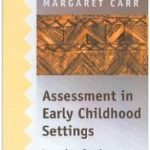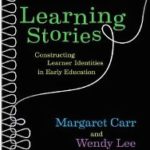Articles
Learning Stories – Using Your Observations for Assessment

 I had the great pleasure of returning to Birmingham recently. This was to so do some training with a group of enthusiastic and knowledgeable practitioners on Observations for Assessments.
I had the great pleasure of returning to Birmingham recently. This was to so do some training with a group of enthusiastic and knowledgeable practitioners on Observations for Assessments.
One of the techniques that I had chosen to focus on was Learning Stories. Margaret Carr was promoting Learning Stories as a method for assessment over 10 years ago, so it’s not a new idea. However, it is an opportune time to return to them as the discussion about how to assess children looks to return (BBC Website).
I really like Learning Stories because they are positive reinforcements of your child’s achievements and because they are very personal records.
What are Learning Stories?
Learning Stories are described by Margaret Carr as structured narratives that are ‘written vignettes of individual children’ (Carr, 2001: 90). A learning story is an account of a significant experience in a child’s life. This may be as simple as watching paint dribble down the page or climbing the steps for the first time.
My particular enjoyment with them is that they emulate a conversation between practitioner and child. They are very personal, from the heart accounts, that really engage both parties.
They are not designed to make judgments or tick developmental boxes – but are a celebration of your child’s abilities and interests.
How do I write one?
Remember that first and foremost it is a story, a tale to be told, and should be written in that style. The narrative begins with something initiated by your child, whether that is an activity or achievement or idea.
The structure usually has four stages:
- Initiation of the activity
- Becoming involved. This is where your child is engaged and using their learning dispositions.
- Causing something to happen. This is the intentionality of the activity and is at the heart of the observation. What was it that you observed? What does this tell you about your child? How does this demonstrate learning, knowledge or understanding?
- Implications. What does this mean for your child? Is it something new or novel? How can you extent or embed the learning? How can you support or encourage further learning?
The learning story may end with further developments. These are the opportunities and possibilities that may come from the observation. These may also include conversations and comments from parents and carers, once they have read the Learning Story.
The language should be supportive and written as a positive (not deficit) account. It is most effective when written in the first person, just as you would talk to your child.
A range of accompanying photographs help to illustrate the observation.
Using Learning Stories for Assessment
The Learning Story is not only a set of observations, but is a positive way to assess children’s learning. Many areas of learning and development will be recorded by observing a full activity or experience. Tick sheets and coloured boxes will give you a snap shot – a frozen moment in time – whereas a Learning Story is a full colour video of your child’s achievements. They give a rounded, holistic view of development, which is, after all, the way that children develop.
In addition to all that, it is a lovely record for you, parents and carers to keep.
Further Reading and examples
You can see some examples of Learning Stories on Tom Drummond’s site: Tom Drummond
There are Learning Story templates on the Aussie Childcare Network and for the iPad: Educa Blog
References
Carr, M. (2001) Assessment in Early Childhood Settings: Learning Stories London: Sage
Drummond, T. (2010) Learning Stories: Conventions for writing. Available from: http://earlylearningstories.info/ Accessed 28th June 2012
Kathy Brodie
https://www.kathybrodie.com/author/kathy-brodie/Kathy Brodie is an author, Early Years Professional and Trainer specialising in online training and courses. She is the founder and host of the Early Years Summit and Early Years TV, weekly Professional Development for Early Years practitioners and educators.

AUTHOR Lynn Rupe
Posted on 12:55 am January 27, 2020.
Kia ora Kathy
I did not read the date of your post. This was quite some time ago which makes me curious about your journey into Learning Story assessment. I hope that you continued with the passion that you post relays.
I have enjoyed listening to many of your webinars such a great way to stretch teaching practice.
Lynn
AUTHOR Lynn Rupe
Posted on 8:02 pm January 26, 2020.
Kia ora Kathy
Wendy Lee and Margaret Carr have published another book called Learning Stories in Practice which has many wonderful examples of Learning Stories from New Zealand and other countries.
I agree with Annette’s comment, Learning Stories are a celebration of the learning that has happened written in the notice ( narrative), recognise(what learning I saw) and respond (how we can support the learning further) format.
They are a wonderful way to celebrate skills, knowledge and dispositions retrospective in order that children still have agency over their own learning. The ‘we’ in how can we support the learning is the child, teacher and family. As you say they are a great conversation amongst teachers, children and family.
They should be rich with the language of learning to support children’s view of themselves as learners.
We have a closed Facebook page that celebrates Learning Stories and the power of these to transform teachers practice. The page also has many examples of Learning Stories. https://www.facebook.com/groups/1017415695001078/
As an organisation we support teachers around the world with Learning Story writing because we see this as away of ensuring teacher practice shifts into a space where the things that matter are at the forefront. Values, dispositions and ensuring children have a positive view of themselves as learners and thinkers.
AUTHOR Kathy
Posted on 10:44 pm January 26, 2020.
Thank you so much for such an in-depth and interesting perspective Lynn. Much appreciated.
I hadn’t spotted that there was a new book, which I will hunt out, and thank you so much for the link to Facebook as well.
Very best wishes
Kathy
AUTHOR Annette Whitworth
Posted on 8:06 pm July 7, 2014.
Hi Kathy, great post!
I’m new to EYE (old to everything else!!) and happily learning all the time and was wondering if an opportunity is being missed through the terminology at structure point 3 ‘causing something to happen’? In the playworkers methodology the term ‘freely chosen, intrinsically motivated, self-directed play is used to capture often exquisite learning in young children so I wondered how to avoid observer bias if something is ’caused to happen’?
AUTHOR Kathy
Posted on 11:06 pm July 7, 2014.
Hi Annette,
Many thanks for your comment.
I think the words are a ‘catch-all’ for child initiated, child led, adult initiated, adult provocations etc.
I do like the playworker’s term – very positive.
Avoiding observer bias is really difficult and, arguably, adds its own value to observations. As long as you are self aware and reflexive!
Kathy